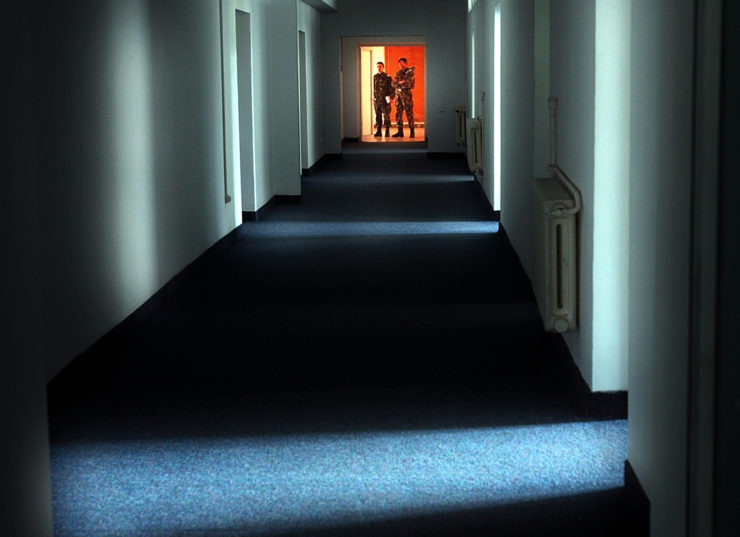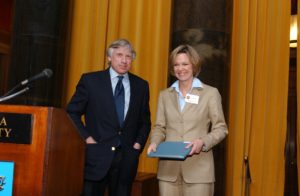
One of the "black site" prisons used by the CIA to interrogate terrorism suspects. This one, shown in 2005, is an air base in Romania.
As a college sophomore in 2005, I read Dana Priest’s report about “black sites” –far-flung secret prisons overseas that the CIA used to house terrorist suspects captured from the battlefields. One in Afghanistan, known as the “Salt Pit,” was a former brick factory. Others were found in Eastern Europe.
I was hooked.
I continued to follow her reports over the years about appalling conditions in Walter Reed Medical Center, which won her and two other Washington Post staffers the 2008 Public Service Pulitzer, and the elaborate “Top Secret America” terrorism industrial complex hiding in plain sight in office parks around the country.
Priest had won her first Pulitzer for the “black sites” reporting, which drew accusations of treason. More than a decade later, the election of President Trump has raised questions — and emotions — about national security issues, including how journalists report on the government.
It seemed like the perfect time to chat with Priest, whose reporting caused the Bush administration to wince, the Obama administration to tackle CIA prisons and the Secretary of the Army to resign.
She spoke by phone at The Washington Post’s offices about her investigations, exercising caution with sensitive sources and treason accusations.
When you started at the Post over three decades ago, what was the political climate like for journalists?
I was an intern during the Cold War (laughs). The very first day I started at the Post, the Iran-Contra scandal was breaking and I believe George Shultz was standing up at a news conference talking about how the Reagan administration had actually traded arms for hostages. I thought: “Where am I! Wow! This is exciting!” The story broke because reporters got pieces of it and forced it out into the open.
Party polarization and partisanism were not as strong as now, but most administrations for as long as I can remember don’t like reporters getting below the surface and figuring out what’s really going on.
Joe Scarborough actually said on the air, if “planes fly into buildings, blame Dana Priest.” NBC made him apologize, but it wasn’t the first time I was called a traitor.
I got in hot water mainly during the Bush administration when reporting on the CIA. They launched a leak investigation that had a chilling effect on sources. They also tried to intimidate reporters and others within the government from talking to reporters about very sensitive things like “black sites” and torture tactics.
How did you discover and begin to inquire about black sites during the Bush administration?
I had been the Pentagon correspondent and wrote extensively about the military.
I wanted to know what they were doing with the prisoners from the battlefield while trying to report on the war in Afghanistan, which was a Special Forces war. Initial inquiries led to some information about POWs being kept in big steel containers and people disappearing.
Three newspapers participated in the unveiling – the Post, The New York Times and The Wall Street Journal. We were parting the curtain bit by bit but didn’t have any idea what we were seeing until we saw “rendition” – taking prisoners off the battlefield and sending them out of the country, or capturing them in Pakistan and sending them to other third countries. Nobody had a clue these could be prisons run by the CIA.
The term “black sites” emerged and we wondered — how do you logistically get people there? I started doing reporting overseas to uncover agreements with other countries and plane transits.
This was a classic investigative story where you have tiny bits of information and then cast a web to create a network of sources. You cast the web a little bit further each time, gathering more information that starts to emerge into new knowledge.

Columbia University President Lee C. Bollinger presents Dana Priest with the 2006 Pulitzer Prize in Beat Reporting.
Your next major national security story, “Top Secret America” in 2010, had significant data components. How did you start tracking the fusion centers and terrorism industrial complex?
I collected the information in my brain but nowhere else starting around 2008. It took a long time to report that story. My head hurt all the time because there was just so much! I was just coming off of a story, and “Top Secret America” had been accumulating in my notes. I’d observed huge growth in Washington, running into people from new agencies and new contractors all the time. In one sense Bill Arkin and I were doing a story that was obvious and in front of us but doing it in a way that made all the pieces very concrete. You have to go deep, then step back and go to a 30,000-foot altitude, look down and say, “What does this all mean?”
I had insights through people in the military and intelligence and got one or two decent briefings, then went to a contracting trade conference, where I saw how many contractors there were and what they were talking about.
Bill Arkin created a searchable database by putting a lot of information he’d come across doing other stories, including organizations and contractors, until there were hundreds and he added a way to filter them.
I did a lot of driving around Washington and other places visiting addresses we would find on the web when we looked at organizations. We discovered an alternative geography of the U.S. that could be mapped out hiding in plain sight. Like a cluster of barnacles on a rock, the contractors were all around the big intel agencies, especially in Washington but also in other parts of the U.S. There were offices that existed on paper, then you’d go to the lobby and they didn’t exist in the lobby directory.
After publishing the Black Sites piece and “Top Secret America,” you were accused of being a traitor for exposing the government. How did you address the accusations?
Beats are where it’s at! Solid beat reporting is ideal to start investigations.
Directly after 9/11, the media climate became “wrapped up in the flag,” meaning if a journalist questioned what the Bush administration was doing to keep us safe from terrorism, it meant that he or she was not patriotic. Joe Scarborough actually said on the air, if “planes fly into buildings, blame Dana Priest.” NBC made him apologize, but it wasn’t the first time I was called a traitor.
The first time someone called me a traitor I felt very personally offended. We journalists printed what we did because that is part of our role, but we have a responsibility to think carefully about the potential harm details in our stories can do. I think we have a responsibility to talk with the government about things we get that are classified to understand what could damage national security. Typically, the government would say “everything,” but that’s not acceptable. There was one case where I killed an entire story because I thought of potential consequences. It’s our responsibility to give readers as much detail as possible without giving them too much information that would be able to be used against the U.S.
For example, in the black sites story we didn’t name the countries, instead saying “Eastern Europe.” We provided enough detail for credibility, but because the administration and president argued with editor Len Downie that naming the countries could cause a backlash against them and cause them not to work with the U.S. anymore. Now we know the countries because of the Senate investigation, and we still have good relationships with them.
Your sources have often been foreign government employees and U.S. government officials, so how do you protect them?
When reaching out to people, don’t put them in a position where they can be vulnerable to government leak investigations. Limit electronic communications because that can be traced. That means meeting with people. Don’t talk to others about who your sources are. You want them to help you cast a big enough circle around your target so you can get sources in different areas, departments, agencies and branches in the government. That way you can use a tip from somebody and go to another department and see if you can get it confirmed or a perspective on it.
I recommend my students use Signal. I don’t recommend the PGP keys because they are a big flag a person in the government is doing something that they should not do.
You’ve managed beat reporting and sensitive investigations at the same time. What is your best advice to aspiring investigative journalists?
Beats are where it’s at! Solid beat reporting is ideal to start investigations. Not only getting to know current people in your beat, but also the people who just left their posts. The former police chief and former senior deputy can give you information because they are no longer constrained, have institutional memory and can be your guide to what’s happening inside. Local police would be a great beat for someone interested in doing investigative work or even national security work because of the sensitive issues police face.
People will open up if you listen carefully. Think about your listening skills when talking to people, including what they don’t say and their body language. Always be respectful to different cultures by showing curiosity and empathy and they will trust you with information.
Jessica Buchleitner is the author of the 50 Women anthology series and producer of a forthcoming book of testimonies from women and girls in Mogadishu, Somalia. She is pursuing a master’s degree in Media Innovation at Northwestern University.

